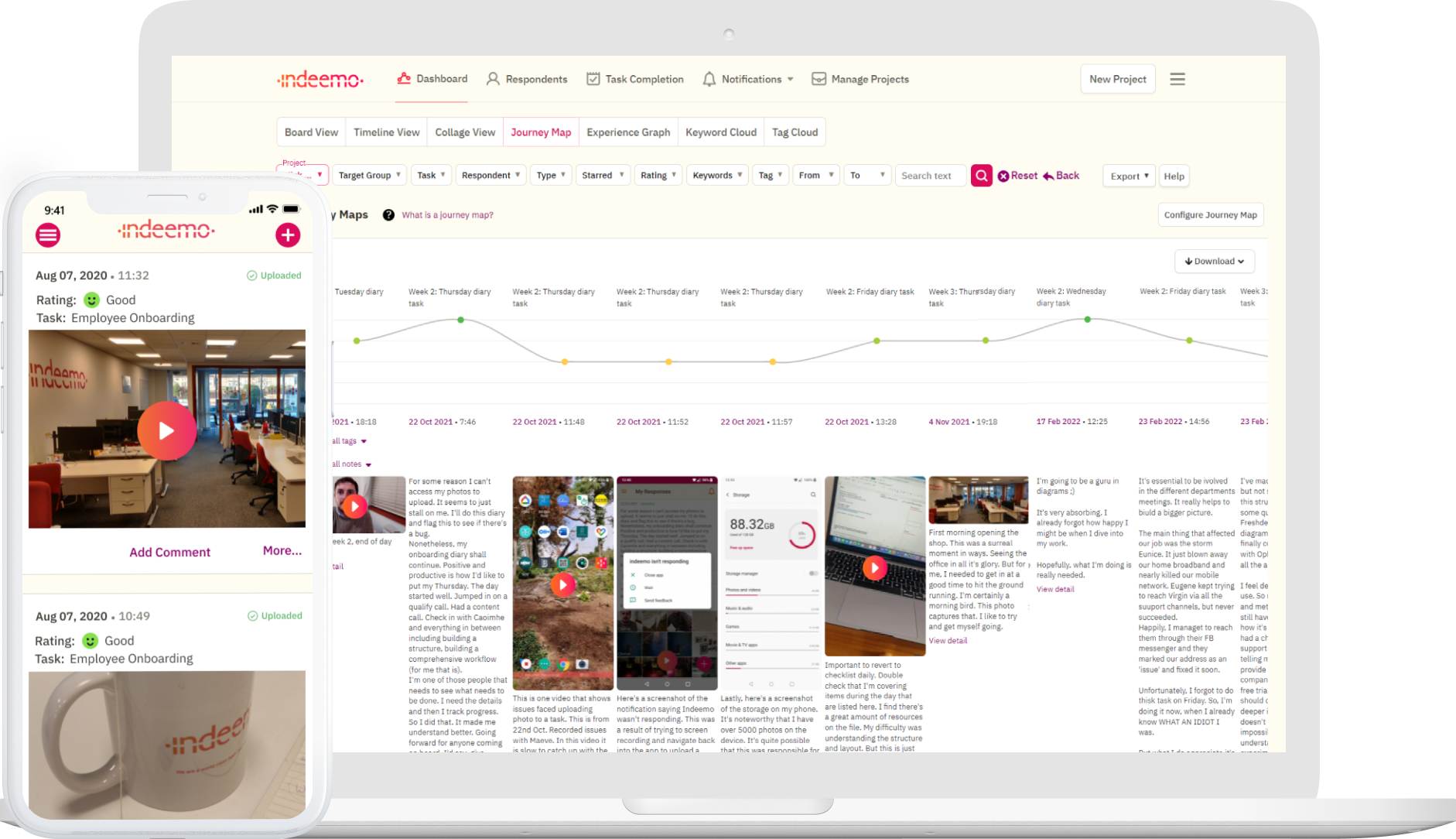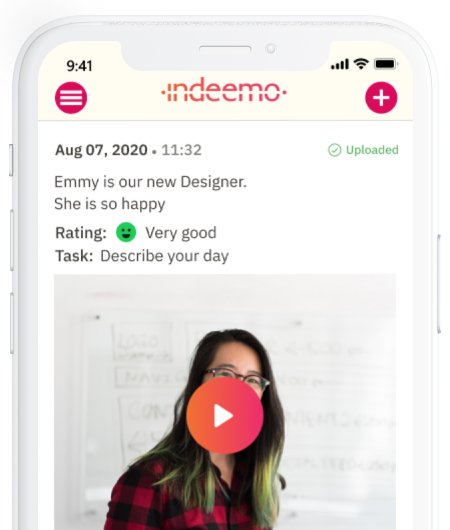The Importance of Journey Mapping in the Employee Lifecycle
Employee Experience management plays a critical role in the shift to becoming an employee centric organisation. In the world of qualitative research, we are seeing a considerable increase in the adoption of new tools and techniques. This is particularly relevant to experience research. Qualitative research methodologies and techniques, such as Digital Ethnography for example, are becoming increasingly optimised for exploratory research. Why? It is clear that researchers and insights teams garner more flexibility and see reduced costs when they are afforded the ability to conduct remote qualitative research.
With reference to the tools available to researchers, it is not surprising that this shift to remote qualitative and exploratory research has seen a rise in the need for technological capabilities that can capture insights across many different environments. This requirement transcends directly across to employee experience research.
Employee Experience Research
Employee Experience (EX) Research, involves the tools, techniques, and strategies adopted by EX management and researchers to first uncover insights into the lives of the employee - and second, to leverage these insights for improvements to employee experience standards and processes.
We have learned a substantial amount about the requirements of organisations to become increasingly employee-centric. This has become more prevalent over the past two years as traditional modes of working, recruitment, and onboarding of new starters was overturned as a result of the pandemic. As a qualitative experience research platform, the pivot to remote working coincided with the launch of the Indeemo journey mapping tool. Working closely with clients, we began to see why EX management and insights teams found it difficult to bridge the disconnect between higher management and employees.
The employee lifecycle, whilst not overly complex, is not the same for every employee. This echoes our understanding of the customer experience also. Of course, CX and consumer journeys are that bit more complex, however, the fact that each customer experience is different is very much reflective of that for employees also.
After supporting a range of diverse projects surrounding employee experience research, it became quite clear that having journey mapping as part of the researchers toolkit helped bridge this gap, amongst other key requirements for organisations. Below, we have listed a number of reasons that highlight the importance of journey mapping in the employee lifecycle.
Putting the spotlight on different stages of the Employee Lifecycle
First, a key learning that we uncovered about employee experience research and journey mapping is focus. In one way, the entirety of the employee lifecycle can be viewed as a journey in itself. The employee lifecycle aims to describe each stage employees experience and are immersed in, from the moment they engage with your application and recruitment process, to their exit from your company.
Employee Lifecycle
When we extract one of the stages of the lifecycle we find that, in their own right, they have a unique journey. For example, when we look at the onboarding experience there are usually a set of procedures and processes new starters go through before becoming immersed in your organisation's EX culture. So, what does the journey mapping process look like through the lens of one stage of the employee lifecycle and leveraged by a journey mapping tool?
When we utilise employee journey mapping, we adopt the capabilities of generating contextual insights into the micro experiences of this stage of the life cycle. For example, an employee journey mapping tool leveraged for the purpose of understanding the onboarding experience will, more often than not, present you and your team with specific areas that work well for new starters. In contrast, you will uncover areas for improvement. By zooming in, or putting the spotlight on one stage of the employee lifecycle, problems can be identified where actions can be taken.
An employee journey mapping tool will enable you and your team to capture experiences within the onboarding journey for example. This means even further, that as an employee-centric organisation, you can dedicate time and resources to implementing strategic decisions that are underpinned by insights coming directly from your new starters. As such, paving the way for improved experiences for your next onboarding process.

Understanding the difference between the Individual Journey & the Collective
Taking the onboarding journey again as an example of the importance of journey mapping - it is not uncommon to see new starters (particularly following a large recruitment drive) grouped together. We can even view this as a type of ‘new starter silo’. Although new joiners will have different roles and responsibilities, it is easy to lose sight of the individual experiences across the onboarding journey due to this unanticipated grouping.
When you implement employee journey mapping within one (or more) of the stages of the life cycle, the differences between the individual's journey and collective journey can quickly inform EX management and decision making. Not only does mapping the employee journey capture the collective experiences, it presents us with the individual human experiences. This is key to becoming employee-centric. On the one hand, employee journey mapping will help you uncover those micro components of the onboarding journey, for example - but in addition, it is here that we begin to see empathy building.
It is one thing to be able to understand the employee experience, but transforming that understanding into an empathic approach to your employees will always present new opportunities for EX improvements. Empathy is always a key component of, not only journey mapping, but qualitative and exploratory research relative to human experiences. We express this importance to clients and EX management who are new to employee journey mapping and are used to conducting traditional quantitative methods for employee experience research, such as employee satisfaction surveys.
Humanising Insights to get under the hood of Quantitative Data
Employee satisfaction surveys have served organisations, HR teams, and EX management teams for many years. They are easy to distribute across your organisation and enable you to gather quantitative data from your employees relatively quickly. Like any data gathering technique, there are always going to be a number of limitations. For instance, with a quantitative approach, there is always the possibility that you will obtain similar data across each employee segment or department in your organisation. The issues you face with this is that you have increased difficulty capturing rich insights that bring you closer to the employee experience.
When we work with clients looking to uncover emerging trends and unknown insights into the employee experience, we don't throw away the old playbook. Any data is better than no data at all. Instead, we collaborate with organisations to dive deeper into the employee experience. Journey mapping helps us to achieve this. How? To simply put it, the journey mapping process, operationalised by the technological capabilities of the journey mapping tool, captures the qualitative data of EX. This added layer can help us get to the closest version of truth. That is, to uncover the real employee experiences.
Indeemo Employee Journey Mapping App and Dashboard
Additionally, your employees document their experiences in the moment across one or more of the stages within their life cycle at your company. These experiences will more often than not come in the form of video or photo. As you implement your employee experience research with journey mapping underpinning the data collection and field work, each employee map automatically generates. The importance of this approach means that you and your team can cross analyse the qualitative data with the quantitative. This added layer of insights can be leveraged to implement process improvements, EX initiatives, and bring you closer to an employee-centric culture.
Contact us
We’ve supported thousands of research projects covering everything from mapping the path to purchase for aquarium filters to mortgage buyer journeys to mapping the patient journey of kidney transplant patients.
If you’d like to discuss a specific patient diary research project or are just curious to learn more, get in touch now.







